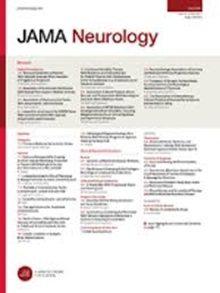Influenza With and Without Oseltamivir Treatment and Neuropsychiatric Events Among Children and Adolescents.
IF 21.3
1区 医学
Q1 CLINICAL NEUROLOGY
引用次数: 0
Abstract
Importance Reports of pediatric neuropsychiatric events during influenza treatment with oseltamivir have prompted public concerns. However, whether oseltamivir or influenza infection is associated with increased risk of neuropsychiatric events remains unclear. Objective To determine the association between influenza, oseltamivir, and serious neuropsychiatric events. Design, Setting, and Participants This retrospective cohort study was conducted in a population-based ambulatory setting during the 2016 to 2017 and 2019 to 2020 influenza seasons. Follow-up began on the first day of the influenza season and continued through the earliest occurrence of an outcome event, loss of enrollment, death, age 18 years, or end of the season or study. Children aged 5 to 17 years enrolled in Tennessee Medicaid were for eligible for inclusion. Data analysis was completed from July 2023 to March 2025. Exposures Each person-day of follow-up was assigned to 1 of the following 5 mutually exclusive exposure groups: (1) untreated influenza; (2) treated influenza; (3) posttreatment period (period between oseltamivir completion and end of influenza period); (4) influenza prophylaxis; and (5) no exposure. Main Outcomes and Measures The primary outcome was a neuropsychiatric event requiring hospitalization, and events were identified using a validated algorithm. Poisson regression estimated incidence rate ratios (IRRs) while accounting for relevant covariates measured on each person-day. Sensitivity analyses examined robustness of findings to alternate exposure and outcome definitions, time-varying outcome risk, negative control outcome, and unmeasured confounding. Results Among 692 975 eligible children, a total of 692 295 children (median [IQR] age, 11 [7-14] years; 50.3% female) experienced 1230 serious neuropsychiatric events (898 neurologic and 332 psychiatric) during 19 688 320 person-weeks of follow-up. Among the 151 401 influenza episodes, 66.7% (95% CI, 66.5%-67.0%) were dispensed oseltamivir (60.1% [95% CI, 59.6%-60.6%] among those at high risk for influenza complications). The most common events overall were mood disorders (36.3%) and suicidal or self-harm behaviors (34.2%). Compared with untreated influenza, event rates were lower during oseltamivir-treated influenza periods (IRR, 0.53; 95% CI, 0.33-0.88) and posttreatment periods (IRR, 0.42; 95% CI, 0.24-0.74). Subanalyses suggest that this finding is driven more by a reduction in neurologic events (IRR, 0.45; 95% CI, 0.25-0.82) than psychiatric events (IRR, 0.80; 95% CI, 0.34-1.88). Sensitivity analyses suggest misclassification or unmeasured confounding would not explain these findings. Conclusions and Relevance In this cohort study, oseltamivir treatment during influenza episodes was associated with a reduced risk of serious neuropsychiatric events. These findings support oseltamivir use for prevention of these influenza-related complications.儿童和青少年接受和不接受奥司他韦治疗的流感和神经精神事件。
关于奥司他韦治疗流感期间儿童神经精神事件的报道引起了公众的关注。然而,奥司他韦或流感感染是否与神经精神事件风险增加有关仍不清楚。目的确定流感、奥司他韦与严重神经精神事件之间的关系。设计、环境和参与者本回顾性队列研究于2016 - 2017年和2019 - 2020年流感季节在以人群为基础的门诊环境中进行。随访从流感季节的第一天开始,一直持续到最早发生结果事件、未入组、死亡、18岁或流感季节或研究结束。参加田纳西州医疗补助计划的5至17岁儿童符合纳入条件。数据分析时间为2023年7月至2025年3月。每个人/天的随访被分配到以下5个相互排斥的暴露组中的一个:(1)未经治疗的流感;(2)治疗过的流感;(3)治疗后期(奥司他韦完成治疗至流感期结束期间);(4)预防流感;(5)不暴露。主要结局和测量主要结局是需要住院治疗的神经精神事件,并使用经过验证的算法确定事件。泊松回归估计发病率比(IRRs),同时考虑到每个人日测量的相关协变量。敏感性分析检验了研究结果对交替暴露和结果定义、时变结果风险、阴性对照结果和未测量混杂因素的稳健性。结果692 975名符合条件的儿童中,共有692 295名儿童(中位[IQR]年龄为11[7-14]岁;50.3%的女性)在19 688 320人周的随访期间经历了1230次严重神经精神事件(898次神经事件和332次精神事件)。在151次 401次流感发作中,66.7% (95% CI, 66.5%-67.0%)使用了奥司他韦(60.1% [95% CI, 59.6%-60.6%]为流感并发症高危患者)。最常见的事件是情绪障碍(36.3%)和自杀或自残行为(34.2%)。与未经治疗的流感相比,在奥司他韦治疗的流感期间,事件发生率较低(IRR, 0.53;95% CI, 0.33-0.88)和治疗后时间(IRR, 0.42;95% ci, 0.24-0.74)。亚分析表明,这一发现更多是由神经系统事件的减少所驱动的(IRR, 0.45;95% CI, 0.25-0.82)大于精神事件(IRR, 0.80;95% ci, 0.34-1.88)。敏感性分析表明,错误分类或未测量的混杂因素不能解释这些发现。结论和相关性在这项队列研究中,流感发作期间奥司他韦治疗与严重神经精神事件的风险降低相关。这些发现支持使用奥司他韦预防这些流感相关并发症。
本文章由计算机程序翻译,如有差异,请以英文原文为准。
求助全文
约1分钟内获得全文
求助全文
来源期刊

JAMA neurology
CLINICAL NEUROLOGY-
CiteScore
41.90
自引率
1.70%
发文量
250
期刊介绍:
JAMA Neurology is an international peer-reviewed journal for physicians caring for people with neurologic disorders and those interested in the structure and function of the normal and diseased nervous system. The Archives of Neurology & Psychiatry began publication in 1919 and, in 1959, became 2 separate journals: Archives of Neurology and Archives of General Psychiatry. In 2013, their names changed to JAMA Neurology and JAMA Psychiatry, respectively. JAMA Neurology is a member of the JAMA Network, a consortium of peer-reviewed, general medical and specialty publications.
 求助内容:
求助内容: 应助结果提醒方式:
应助结果提醒方式:


